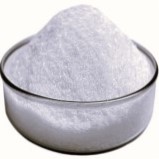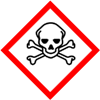 |
Etoricoxib SDS Safety Data Sheet of Supplier Exporter Manufacturers' Representative |
Email: info@ammol.org |
Call Toll Free +1-855-552-6665 |
Etoricoxib
CAS Number: 202409-33-4
Molecular Formula: C18H15ClN2O2S
Molecular Weight: 358.84

Etoricoxib
Etoricoxib SDS GHS, Safety Data Sheet
MSDS Sheet, Material Safety Data Sheet 05-Feb-25
1. Product Identification
Product Name & Other Names: Etoricoxib.
CAS No.: 202409-33-4
EINECS EC No.: 682-421-5
Relevant uses and uses advised against (if any): Industrial Manufacturing.
Suppliers: As per letterhead.
2. Hazards Identification
GHS, Globally Harmonized System Classification in accordance with 29 CFR 1910
Hazard Class and Category Code(s), Regulation (EC) No 1272/2008 (CLP):
Acute toxicity, Oral (Category 4), H302
Acute toxicity, Dermal (Category 1), H310
Labeling according to Regulation (EC) No 1272/2008
GHS Label Elements  Toxic |
Signal Words: Danger
Hazard statements:
H302: Harmful if swallowed.
H310: Fatal in contact with skin.
Precautionary statements:
P210: Keep away from heat/sparks/open flames/hot surfaces – No smoking.
P233: Keep container tightly closed.
P270: Do not eat, drink or smoke when using this product.
P271: Use only outdoors or in a well-ventilated area.
P280: Wear protective gloves/protective clothing/eye protection/face protection.
P312: Call a POISON CENTER or doctor/physician if you feel unwell.
P301+310: IF SWALLOWED: Immediately call a POISON CENTER or doctor/physician.
P303+361+353: IF ON SKIN (or hair): Remove/Take off immediately all contaminated clothing. Rinse skin with water/shower.
P304+340: IF INHALED: Remove victim to fresh air and keep at rest in a position comfortable for breathing.
P305+351+338: IF IN EYES: Rinse cautiously with water for several minutes. Remove contact lenses if present and easy to do – continue rinsing.
P403+233+235: Store in a well-ventilated place. Keep container tightly closed. Keep cool.
3. Composition/Information on Ingredients
Product Name & Other Names: Etoricoxib.
CAS No.: 202409-33-4
EINECS EC No.: 682-421-5
4. First Aid Measures
Always seek medical attention after first aid measures are provided.
Inhalation: Remove to fresh air. If not breathing, give artificial respiration. If breathing is difficult, give oxygen. Get medical attention.
Ingestion: Never give anything by mouth to an unconscious person. Get medical attention.
Skin Contact: Wipe off excess material from skin then immediately flush skin with plenty of water for at least 15 minutes. Remove contaminated clothing and shoes. Get medical attention. Get medical attention.
Eye Contact: Immediately flush eyes with plenty of water for at least 15 minutes, lifting lower and upper eyelids occasionally. Get medical attention immediately.
5. Fire Fighting Measures
Flammability of the Product: Not a fire hazard. However, it can burn at high temperature
Products of Combustion: Carbon dioxide, Carbon monoxide, Nitrogen oxides, Sulfur oxides and fumes.
Explosion: Explosive in presence of heat.
Fire Extinguishing Media: Use dry chemical, foam, water spray, carbon dioxide. Flammable liquid and vapor. Vapors are heavier than air and may travel to a source of ignition and flash back. Vapors can spread along the ground and collect in low or confined areas. Avoid solid water jet as it can scatter the fire. Cool containing vessels with water jet to prevent pressure build-up, auto-ignition, or explosion.
Special Information: In the event of a fire, wear full protective clothing and NIOSH-approved self-contained breathing apparatus with full face piece operated in the pressure demand or other positive pressure mode.
6. Accidental Release Measures
Personal precautions, protective equipment, and emergency procedures: Avoid breathing dust/fumes/gas/mist/vapors/spray. Use individual protective equipment (waterproof boots, suitable protective clothing, safety glasses, etc.).
Environmental precautions: Do not let the product enter drains, soil, or water sources.
Methods and materials used for containment cleanup procedures and Storage:
Small Spill: Avoid mist formation. Avoid breathing mist/vapors. Ensure adequate ventilation. Use appropriate tools to put the spilled solid in a convenient waste disposal container.
Large Spill: Remove all sources of ignition. Provide proper ventilation. Keep people away from upwind of spill/leak. Entry to non-involved personnel should be controlled around the leakage area by roping off. Absorb the material on a porous, inert material such as earth, sand, or vermiculite. Carefully sweep up the material without causing dust. Dispose of it in accordance with local regulations.
Large liquid spillages should be contained by use of sand or another inert material. The spillage should be transferred to a suitable container and recovered or disposed of in accordance with local regulations. Because of the danger of spontaneous combustion, any combustible material, such as cloth, used for cleaning spillages, should be saturated with water, and disposed of promptly, preferably by incineration.
7. Handling and Storage
Precautions for safe handling: Apply according to good manufacturing and industrial hygiene practices. Ensure proper ventilation. In case of insufficient ventilation, wear suitable respiratory equipment. Do not drink, eat, or smoke while handling. Avoid contact with skin, eyes, and clothing. Minimize dust generation. Avoid breathing dust/fumes/gas/mist/vapors/spray. Keep container tightly closed. Avoid ingestion and inhalation. Use individual protective equipment (waterproof boots, suitable protective clothing, safety glasses, etc.).
Conditions for safe storage, including any incompatibilities: Store in cool, dry, and ventilated area away from heat sources and protected from sunlight in tightly closed original container. Keep air contact to a minimum. Store protected from heat, sparks and ignition sources and incompatible materials. Avoid inhalation of dust/mist/vapor. Do not store with incompatible materials like strong oxidizing agents. Store locked up. Storage: Refrigerate. 2C to 8C. Short term shipping may be ambient.
8. Exposure Controls/Personal Protection
Airborne Exposure Limits: Not Established.
Ventilation System: A system of local and/or general exhaust is recommended to keep employee exposures as low as possible.
Personal Respirators (NIOSH Approved): For conditions of use where exposure to dust or mist is apparent and engineering controls are not feasible, a particulate respirator may be worn.
Skin Protection: Wear protective gloves and clean body-covering clothing.
Eye Protection: Use chemical safety goggles and/or full-face shield where dusting or splashing of solutions is possible. Maintain eye wash fountain and quick-drench facilities in work area.
Other Control Measures: Maintain good housekeeping in work area. Handle in accordance with good industrial hygiene and safety practice.
9. Physical and Chemical Properties
Appearance: White to light beige powder or crystals. Air Sensitive, Heat Sensitive.
Odor: No information found.
Odor threshold: No information found.
pH: No information found.
Relative density: No information found.
Boiling Point: about 510C predicted.
Melting Point: 132C to 138C literature.
Flash Point: No information found.
Auto-ignition temperature: No information found.
Decomposition temperature: No information found.
Upper/lower flammability or explosive limits: No information found.
Vapor pressure: No information found.
Vapor density: No information found.
Evaporation rate: No information found.
Flammability (solid, gas): No information found.
Partition coefficient: n-octanol/water: No information found.
Solubility: Slightly soluble in water. Soluble in acetone. Very soluble in ethanol, ethyl ether.
Viscosity: No information found.
10. Stability and Reactivity
Stability: Stable under ordinary conditions of use and storage. Vapor/air-mixtures are explosive at high temperatures. Forms explosive mixtures with air on intense heating.
Hazardous Decomposition Products: It emits Carbon dioxide, Carbon monoxide, Nitrogen oxides, Sulfur oxides & Fumes.
Hazardous Polymerization: Will not occur.
Incompatibilities: Strong oxidizing agents.
Conditions to Avoid: Incompatibles, oxidizing agents, heat flame & light.
11. Toxicological Information
Toxicity data:
LD50 Oral Rat: 1499 mg/kg.
LD50 Dermal Rabbit: 50.1 mg/kg.
Carcinogenicity: Not listed by ACGIH, IARC, NTP, or CA Prop 65.
Epidemiology: No information found
Teratogenicity: No information found
Reproductive Effects: No information found
Mutagenicity: No information found
Neurotoxicity: No information found.
12. Ecological Information
Toxicity to fish: No information found.
Persistence and Degradability: Unlikely to persist due to water solubility.
Mobility: Likely to be mobile due to water solubility.
Bioaccumulation/ Accumulation: No information found.
Results of PBT and vPvB assessment: No information found for assessment.
13. Disposal Considerations
Whatever cannot be saved for recovery or recycling should be managed in an appropriate and approved waste disposal facility. Follow all the pollution control rules.
14. Transport Information
DOT USA, TDG Canada & ADR/RID Europe:
Shipping Name: Toxic solid, organic, n.o.s. (Etoricoxib)
Hazard Class: 6.1; Packing Group: II.
UN Number: UN2811.
IMDG/IMO:
Shipping Name: Toxic solid, organic, n.o.s. (Etoricoxib)
Hazard Class: 6.1; Packing Group: II.
UN Number: UN2811.
IATA/ICAO:
Shipping Name: Toxic solid, organic, n.o.s. (Etoricoxib)
Hazard Class: 6.1; Packing Group: II.
UN Number: UN2811.
15. Regulatory Information
USA:
SARA 311/312 Hazards: See section 2.
California prop. 65: Not listed.
16. Other Information
Disclaimer:
**************************
Our company provides this MSDS sheet in good faith but makes no representation as to its comprehensiveness or accuracy. This SDS sheet is intended only as a guide to the appropriate precautionary handling of the material by a properly trained person using this product. The above information has been compiled from various sources and has the possibility of discrepancy and being out-dated information. Individuals receiving the information must exercise their independent judgment and do further search in determining its appropriateness for a particular purpose. In no case shall our company be liable to loss or damages by the product user.
**************************
Please visit Main Page of Etoricoxib Suppliers.
American Molecules, also known as ammol.org is a distributor, supplier and manufacturers' representative of all types of Pharmaceuticals, Functional Ingredients, Excipients and Specialty Chemicals in Texas USA. Our principals manufacture supply and export USP NF BP, Ph Eur, etc grades of chemicals pure and reagent grade, mineral fortifiers, FCC food grade. Tailor made particle size and customized specifications are offered. The principal's facility is having one or more of the certifications like FDA approval and GLP, cGMP, ISO9001, ISO14001, ISO/IEC 17025, ISO22000, FSSC 22000, ISO45001, FSSAI, Kosher, HALAL, COPP, WHO-GMP certified and Written Confirmation (WC) for export to Europe is available. The manufacturers suppliers and exporters observe WHO Good Manufacturing Practices and Good Laboratory Practices.





Suppliers and Manufacturers' Representative:

9910 Bent Oak Dr
Houston, TX 77040, USA
Call Toll Free: 1-855-55-AMMOL 1-855-552-6665
Email: info@ammol.org